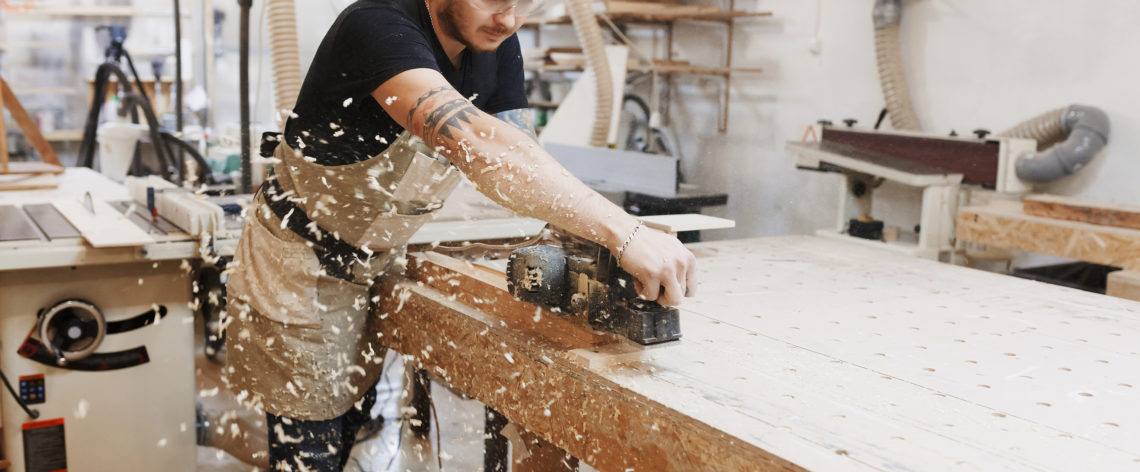While your passion may be turning pieces of wood into functional furniture, running a carpentry business requires much more than knowing your way around a sanding belt.
From meeting market demand and paying bills to investing in staff and new equipment, small carpentry businesses face many competing factors, many of which cost money.
As costs are ever-rising and your budget is wearing a little thin, it’s high time you check out some money-saving tips so your carpentry business can not only survive but thrive.
- Bulk buy your materials
Buying your materials in larger quantities can often mean you can purchase them at a discounted price. Over time you will likely notice that you will use the same materials again and again.
Although only some projects will require you to bulk-buy, purchasing these materials in bulk is a good idea for lower prices. This will also get you into the mindset of purchasing and planning for future expenses, which will help you avoid any nasty, inflationary surprises.
Bulk buying is also eco-friendly as well. You will no longer be stuck with leftover packaging every time a delivery arrives or pay for a new delivery each time. This could make you more efficient and less wasteful.
- Buy cheaper materials
A way to reduce project costs is by using less expensive woodcuts for components that aren’t necessarily visible. You can make your cabinet drawer boxes, dust frames, and cabinet back from secondary woods like poplar or birch plywood, for example. It won’t affect the functionality of your piece, and it will still be attractive and durable at a lower cost.
- optimising your design
Sometimes, carpenters can be guilty of over-designing their projects. While you want to do the best for your clients, you may use materials or do some unnecessary processes to the final design. This wastes time and money, which could be used in other projects.
You can often look for design alternatives that use less material or a quicker process but still achieve the same or similar result.
- Use technology to make your life easier
Throughout the generations, technology has been used to make life easier for carpenters. From the creation of carpentry tools such as axes and chisels that built early homes and furniture to the advent of electricity that issued a new era of woodworking equipment such as CNC machines and drills, the technological evolution of carpentry has taken many twists and turns.
Now the new era has arrived. From smartphone apps that calculate wood humidity to online invoicing software that vastly improves admin processes, there are many new digital tools out for carpentry businesses that could make things more efficient.
- Sorting out your carpenters insurance
While the previous tips will help you save, sorting out your carpenters insurance is designed to safeguard your business from unforeseen expenses.
Carpentry businesses face a variety of risks in their day-to-day operations – some you can sort out yourself while others you may need protection for.
A claim against your business could blow your budget out and destroy any previous attempt to scrimp and save.
Here are some of the key insurance for carpenters:
Public Liability insurance is a critical type of insurance for carpenters and is often required to enter many worksites.
It is designed to cover the legal fees and costs of compensation if a third party claims against you for injury or property damage due to your negligent business activities.
Whether it’s a supplier tripping over some leftover wood or an ill-timed cut damaging a client’s property, Public Liability insurance could be the difference between staying in business or closing up shop.
Business Insurance* is an insurance package designed to cover your carpentry business’ contents, stock, tools and commercial premises when an insured event occurs (such as fire, storm, theft or even accidental damage). A Business Insurance package can also cover your portable equipment, glass, and loss of revenue due to business interruption in specified circumstances.
You also can add a variety of other cover to your Business Insurance package, such as public liability, tax audit, employment practices and statutory liability risks.
The bottom line
Running a carpentry business is tough work. Not only does it require technical skill, but you also need to know how to run a business. Hopefully, these tips and tricks can help you improve your bottom line so you can keep building for years to come.
This information is general only and does not take into account your objectives, financial situation or needs. It should not be relied upon as advice. As with any insurance, cover will be subject to the terms, conditions and exclusions contained in the policy wording. © 2022 BizCover Pty Limited, Public Liability Australia is a business name of BizCover Pty Ltd (ABN 68 127 707 975; AFSL 501769)



